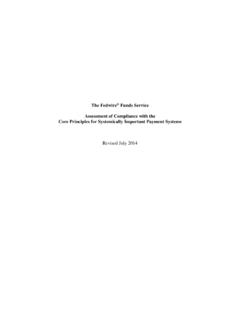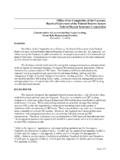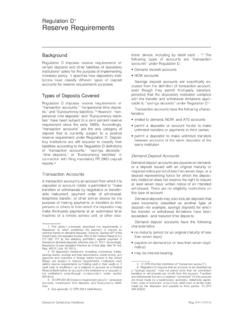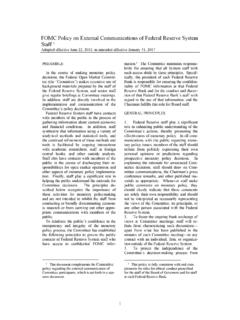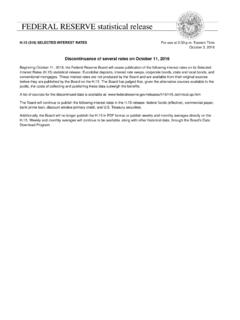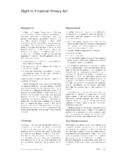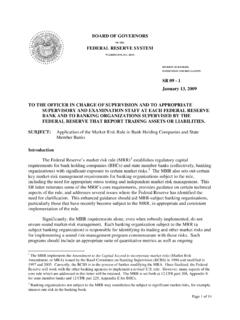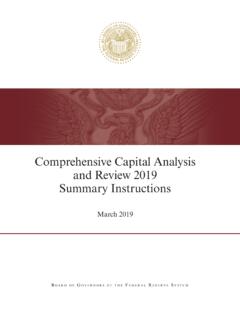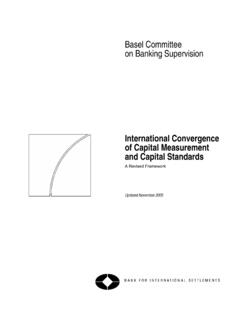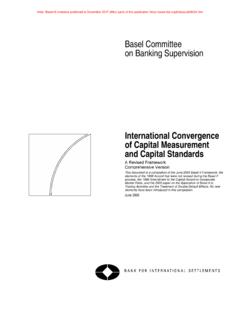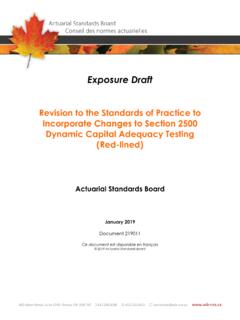Transcription of Comprehensive Capital Analysis and Review 2018: …
1 Comprehensive Capital Analysisand Review 2018: assessment Framework and ResultsJune 2018BO A R D O F GO V E R N O R S O F T H E FE D E R A L RE S E R V E SY S T E MComprehensive Capital Analysisand Review 2018: assessment Framework and ResultsJune 2018BO A R D O F GO V E R N O R S O F T H E FE D E R A L RE S E R V E SY S T E MThis and other Federal Reserve Board reports and publications are available online order copies of Federal Reserve Board publications offered in print,see the Board s Publication Order Form ( )or contact:Printing and FulfillmentMail Stop K1-120 Board of Governors of the Federal Reserve SystemWashington, DC 20551(ph) 202-452-3245(fax) 202-728-5886(email) Federal Reserve promotes a safe, sound, andefficient banking and financial system that supportsthe growth and stability of the economythrough its supervision of bank holding companies(BHCs), intermediate holding companies (IHCs),savings and loan holding companies, state memberbanks, and nonbank financial institutions that theFinancial Stability Oversight Council (FSOC) hasdetermined shall be supervised by the Board of Gov-ernors of the Federal Reserve System (Board).
2 1 The Federal Reserve has established frameworks andprograms for the supervision of its largest and mostcomplex financial institutions to achieve its supervi-sory objectives, incorporating the lessons learnedfrom the 2007 to 2009 financial crisis and in theperiod since. As part of these supervisory frame-works and programs, the Federal Reserve assesseswhether BHCs with $100 billion or more in totalconsolidated assets and IHCs (together, firms)are sufficiently capitalized to absorb losses duringstressful conditions, while meeting obligations tocreditors and counterparties and continuing to beable to lend to households and The Fed-eral Reserve s expectations for Capital planning prac-tices are tailored to the size, scope of operations,activities, and systemic importance of a particularfirm.
3 In particular, the Federal Reserve has height-ened expectations for BHCs and IHCs super-vised by the Large Institution Supervision Coordi-nating Committee (LISCC firms) and large andcomplex firms. 3 This annual assessment includes two relatedprograms: The Comprehensive Capital Analysis and Review (CCAR) consists of a quantitative assessment forall firms, and a qualitative assessment for firmsthat are LISCC or large and complex firms. Thequantitative assessment evaluates a firm s capitaladequacy and planned Capital distributions, suchas any dividend payments and common stockrepurchases. The Federal Reserve assesses whetherfirms have sufficient Capital to continue operatingand lending to creditworthy households and busi-nesses throughout times of economic and financialmarket stress, even after making all planned capitaldistributions.
4 CCAR also includes a qualitativeassessment of Capital planning practices at thelargest and most complex firms. As part of thequalitative assessment , the Federal Reserve evalu-ates the reliability of each firm s analyses andother processes for Capital planning, focusing onthe areas that are most critical to sound capitalplanning namely, how a firm identifies, measures,and determines Capital needs for its materialrisks and a firm s controls and governancearound those practices. At the conclusion of theprocess, the Federal Reserve either does not objector objects to a firm s Capital plan. If the FederalReserve objects to a firm s Capital plan, the firmmay only make Capital distributions that the Fed-eral Reserve has not objected to in writing. Dodd-Frank Act supervisory stress testing is aforward-looking quantitative evaluation of theimpact of stressful economic and financial marketconditions on firms Capital .
5 The supervisory stresstest that is carried out pursuant to the Dodd-Frank Wall Street Reform and Consumer Protec-tion Act (Dodd-Frank Act) and the Board s rules4serves to inform the Federal Reserve, firms, and1 Information on the Federal Reserve s regulation and supervi-sion function, including more detail on stress testing and capitalplanning assessment , is available on the Federal Reserve websiteat 2 Enacted on May 24, 2018, the Economic Growth, RegulatoryRelief, and Consumer Protection Act (EGRRCPA) raised theasset thresholds for application of section 165 of the Dodd-Frank Wall Street Reform and Consumer Protection Act. TheBoard will not disclose the current CCAR results for BHCswith greater than or equal to $50 billion but less than $100 bil-lion in total consolidated assets.
6 This document reflects and complex firms are BHCs or IHCs that (1) haveaverage total consolidated assets over $250 billion or (2) haveaverage total nonbank assets of $75 billion or more, and (3) arenot LISCC L. No. 111-203, 124 Stat. 1376 (2010); 12 CFR part 252,subpart general public of how institutions capitalratios might change under a hypothetical setof stressful economic conditions developed by theFederal Reserve. The supervisory stress test results,after incorporating firms planned Capital actions,are also used for the quantitative assessment inCCAR. All BHCs with $100 billion or more intotal consolidated assets and IHCs are cur-rently subject to Dodd-Frank supervisory , the nonbank financial company supervised by theBoard is not subject to the Capital planning or stress CCAR 2018: assessment Framework and ResultsExecutive Summary.
7 1 Overview of Aggregate Results .. 3 Requirements in CCAR 2018 .. 7 Quantitative assessment Framework and Summary of Results .. 9 assessment Framework .. 9 Summary of Quantitative Results .. 10 Qualitative assessment Framework, Process, and Summary ofResults .. 19 Overview of Qualitative assessment Framework .. 19 The Qualitative assessment Process .. 19 Qualitative assessment Results .. 24 Process and Requirements after CCAR 2018 .. 25 Execution of Capital Plan and Consequences of a Federal Reserve Objection to a Plan .. 25 Resubmissions .. 25 Appendix A: Disclosure Tables .. 27vContentsExecutive SummaryLarge financial institutions have more than doubledtheir Capital levels since the financial crisis, in partbecause of supervisory programs like CCAR. (Formore information on recent trends in Capital levels,see box 1.)
8 Capital is central to a firm s ability toabsorb losses and continue operating and lending tocreditworthy businesses and crisis illustrated that confidence in the Capital -ization and overall financial strength of a financialinstitution can erode rapidly in the face of changes incurrent or expected economic and financial condi-tions. More importantly, the crisis revealed that sud-den actual or expected erosions of Capital can lead toloss of investor and counterparty confidence in thefinancial strength of a systemically important finan-cial institution, which may not only imperil thatinstitution s viability, but also harm the broaderfinancial system. For this reason, the Federal Reservehas made assessments of Capital planning and post-stress Analysis of Capital adequacy a cornerstone ofits supervision of the largest financial Federal Reserve s annual CCAR exercise is anintensive assessment of the Capital adequacy andcapital planning practices of large financialinstitutions.
9 Large and noncomplex firms withtotal consolidated assets of $100 billion or more arerequired to submit Capital plans and demonstrate anability to meet their minimum Capital requirementsunder stress as part of CCAR s quantitative assess-ment but are not subject to CCAR s qualitativeassessment of their Capital planning that are LISCC or large and complex firms7are subject to both the qualitative and quantitativeassessment processes of CCAR, and their capitalplans can be objected to on either quantitative orqualitative quantitative assessment helps to ensure thatfirms maintain sufficient Capital to continue opera-tions throughout times of economic and financialmarket stress. The horizontal nature of the assess-ment offers insights into the condition of the system, including whether firms are suffi-ciently resilient to continue to lend to householdsand businesses under such adverse conditions.
10 TheCCAR process can also act as a counterweight topressures that a firm may face to use Capital distribu-tions to signal financial strength, even when facing adeteriorating or highly stressful qualitative assessment seeks to ensure that firmshave strong practices for assessing their Capital needsthat are supported by: effective firmwide identifica-tion, measurement, and management of their mate-rial risks; strong internal controls; and effective over-sight by senior management and boards of focusing on the key elements of Capital planning,the qualitative assessment helps promote better risk6 Large and noncomplex firms are BHCs or IHCs that(1) have average total consolidated assets of $50 billion ormore, but less than $250 billion, (2) have average total nonbankassets of less than $75 billion, and (3) are not global sys-temically important banks.
